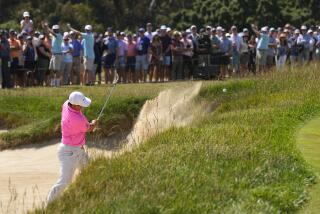Getting in the Swing: Exercises That Improve Your Golf Game
All those years of miniature golfing with my kids really paid off when my husband and I hit the links on a recent vacation: My putting was excellent. The rest of my game, however, needed some work. So did my body when I woke up the next morning.
Given the amount of torque and muscle strength required to drive a golf ball, it’s no wonder that golf so often leads to some debilitating injuries, particularly to the lower back. The deceptively simple rhythmic movement of swinging a golf club can have devastating consequences on an unprepared body.
That’s because we tend not to think of golf as an athletic activity requiring conditioning. But all sports, including golf, require specificity of training--training that targets those specific muscles used. Training for a marathon, for example, doesn’t condition you to run hurdles. So the aches I felt in my rotator cuff and forearms were in muscles that I rarely use, even though I work out extensively.
Before playing another round, I decided to consult Wayne Westcott, PhD, a fitness researcher who has studied the biomechanics of golf swings. He explained that the golf swing is an incredibly complex series of movements involving most of the body’s major muscle groups. (It’s so complex, in fact, that--as golfers know too well--one great shot doesn’t necessarily lead to another.) Each swing begins with the legs, which give the swing its power. That power is transferred by the muscles in the midsection into the torso, which then accelerates the swing. In turn, the arm muscles control and channel that power and determine the speed at which the club head is traveling when it meets the ball.
Obviously, the stronger and more flexible all those muscle groups are, the more explosive--and controlled--the swing can be. And the more likely the golfer is to avoid injury.
*
To build a foundation for muscular endurance, a golfer’s strength program should be divided into three phases. For the first six weeks, until your body becomes adjusted to the weight and movement, choose weights that work your muscles to the point of failure (when you feel as though you can’t go on) after 12 reps of each of eight exercises: squat, bench press, one-arm row, lateral raise, standing biceps curl, triceps extension, back extension and abdominal curl. Rest two minutes between exercises.
For the second six-week phase, you’ll add two exercises to the above: wrist curls and an isometric neck strengthener. You’ll also want to increase the amount of weights so your point of failure is after 10 reps of each of the 10 exercises. Rest 90 seconds between exercises.
The final phase is when you really begin to build muscular strength by adding enough weights to bring your point of failure down to eight reps of each exercise. You’ll also add two more to the above: a shoulder shrug and a lunge. Rest one minute between exercises.
Wayne said studies show that a strength program like this one, done three times a week, enables the average person to drive the ball 10 to 15 yards longer, as well as avoid injury.
Remember, though, that to increase your club head speed, your strength exercises must be done in conjunction with flexibility exercises that enable you to increase your range of motion during movement. This is simple physics, the concept of force being applied over a greater range of motion.
A good stretching program for golf needs to focus on the lower back, upper back, shoulders, hamstrings, quadriceps, gluteals, hips and midsection, which is where torque is generated. Stretch each muscle to the point of slight discomfort and hold for 20 to 30 seconds at least five days a week.
*
Finally, since most golf courses and clubs require players to ride in golf carts to speed up play, cardiovascular fitness plays a minor role in golf. Even so, it can’t hurt your game to have greater lung capacity, particularly on those last few holes, when you’re probably feeling a bit weary anyway. My recommendation is to walk briskly or cycle three sessions a week for at least 30 minutes a session.
What’s funny about golf is that the better you are at it, the less exercise you get doing it. I guess I won’t have to worry about that for a while, though, not after shooting 106. Still, I did get a nice birthday present from my husband when we finished playing: lessons.
*
My April 26 column on the Shooting Stars generated lots of questions from readers. To find out more about the Senior Women’s Basketball Assn., call (619) 268-3086.
*
Copyright 1999 by Kathy Smith
*
Kathy Smith’s fitness column appears weekly in Health. Reader questions are welcome and can be sent to Kathy Smith, Health, Los Angeles Times, Times Mirror Square, Los Angeles, CA 90053. If your question is selected, you will receive a free copy of her book “Getting Better All the Time.” Please include your name, address and a daytime phone number with your question.


